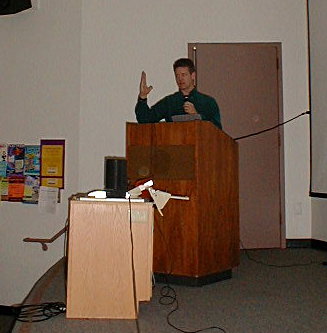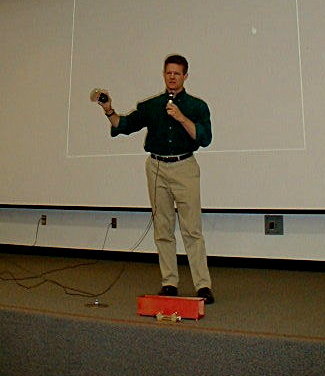






Editor: Kris Cerone
 |
| Rex Ridenoure speaking to OASIS at Cal State Long Beach. Photo courtesy Steve Bartlett. |
Taking a (Virtual) Ride to Orbit
By Steve Bartlett
Since the dawn of space travel, people have long dreamed about flying a rocket to orbit, of looking down and watching the Earth receding in the distance. Ecliptic Enterprises has a way to show what that view would be like with their Rocketcam system of cameras for orbital rockets. Ecliptic's president, Rex Ridenoure, discussed the system in detail in his lecture Earth in Your Rearview Mirror: Ride a Rocketcam to Orbit on September 28 at the California State University, Long Beach campus.
The system, which consists of a camera and housing, a video transmitter, and associated electronics and batteries, has flown aboard Delta and Atlas expendable launch vehicles and recently flew aboard the Space Shuttle mission to the International Space Station. Ridenoure showed spectacular video imagery from several flights, including the ACES, FUSE, Mars Odyssey, and Globalstar missions, as well as those from a number of geostationary satellite launches. Members of the OASIS-invited audience were treated to close-up views of rockets igniting, the Cape Canaveral launch complex shrinking away in the distance, strap-on rocket motors separating and tumbling away, stages and payload fairings separating from the rest of the rocket, and payloads gracefully drifting away from their launchers after deployment. The imagery generated from these flights is useful for analyzing rocket performance, as well as being beautiful.
 |
| Rex Ridenoure with rocketcam. Photo courtesy Steve Bartlett |
The talk covered the history of aerial imagery, from the first pictures taken from balloons in the early 19th century to the systems mounted to the outside of the Space Shuttle. Ridenoure interspersed his comments with rarely-seen videos from Mercury, Gemini, and Apollo missions, as well as a clip from a once-classified Titan satellite launch. He described a rocket flight with the Rocketcam taking place earlier that day in Oklahoma carrying hundreds of paper airplanes made by schoolchildren.
One unusual customer for the system is a pair of skydivers intending to fly a high-altitude balloon to over 120,000 feet. The camera would view the two as they step out of the balloon's gondola on their record-setting freefall. The divers would be wearing spacesuits to protect them from the near-vacuum and extreme temperatures found at that altitude.
The Rocketcam system was originally developed for the Pegasus series of air-launched boosters. The company that formed to market the system later sold the production line to Pasadena-based Ecliptic. Customers for the system have included Boeing, Lockheed-Martin, International Launch Services, NASA, and others. The low cost of the system, typically a few tens of thousands of dollars for an expendable launch vehicle flight, has made it attractive for a number of applications. Besides the rocket camera business, Ecliptic also produces ground support equipment for launch vehicles.
The videos from the Rocketcam system have become very popular with the general public. During the recent Space Shuttle mission, there were so many hits on Ecliptic's website seeking the shuttle launch videos that Ecliptic's server computers crashed several times trying to keep up with the demand. The web pages for the videos had to be taken offline for a time to allow the computers to be reset. (Since then, the traffic on the site has dropped somewhat. interested parties can check out the videos at the Ecliptic web site.)
Before co-founding Ecliptic, Ridenoure had a distinguished career as a space mission engineer and system architect on more than a dozen space missions. He has been a leader in the emerging sector of commercial deep space missions.
Copyright © 1998-2003 Organization for the Advancement of Space Industrialization and Settlement. All Rights Reserved.